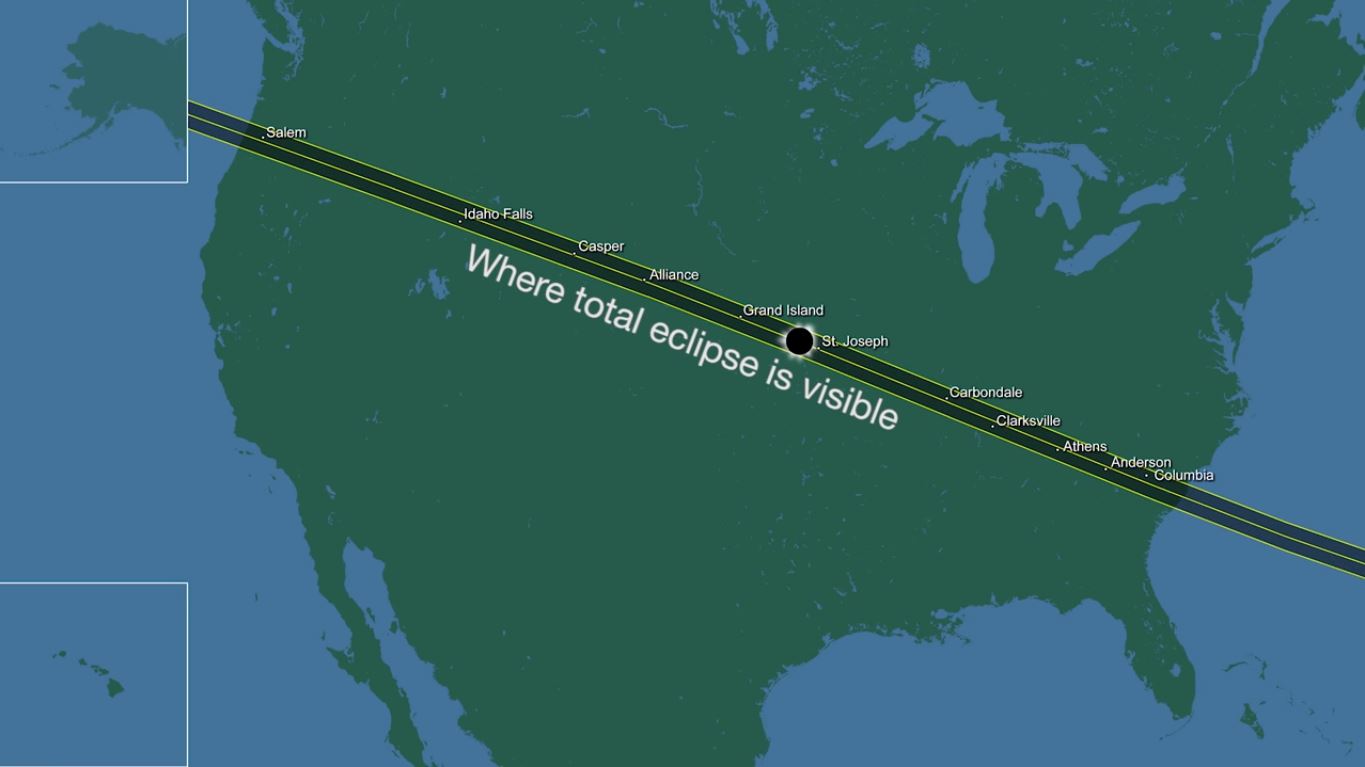First Time Seeing a Total Solar Eclipse? Check Out This Video from NASA
In preparation for the Aug. 21 total solar eclipse, NASA released a short video providing a few skywatching tips and a packing list for first-time eclipse viewers.
The total solar eclipse will cross the U.S. from Oregon to South Carolina along a stretch of land about 70 miles (113 kilometers) wide. Viewers inside the path of totality will experience up to 2 minutes and 40 seconds of darkness as the moon moves between the Earth and sun. Viewers in the U.S. who are outside of the path of totality will still experience a partial eclipse.
If you're planning to travel to see the total solar eclipse, you likely have your hotel booked and a prime viewing spot staked out. Leading up to the day of the eclipse, you may want to visit your viewing spot to make sure there are no trees or buildings that will obstruct your view of the total or partial solar eclipse. Here are some additional tips from NASA to help you make the most of eclipse day. [Solar Eclipse Glasses: Where to Buy the Best, High-Quality Eyewear]
Have eclipse glasses handy
Make sure you have a pair of safety-rated eclipse glasses. Although it is safe to look up at a total solar eclipse (when the solar disk is completely covered by the moon) with the naked eye, you'll need special solar-viewing glasses before and after totality, when part of the solar disk is visible. [The Best ISO-Certified Gear to See the 2017 Solar Eclipse]
Totality will last less than 3 minutes, so you will also want to "have your safe solar-viewing glasses within immediate reach — in your pocket or around your neck, for quick eye protection, before and after totality," Jane Houston Jones, an outreach specialist at NASA's Jet Propulsion Laboratory in California, said in the video.

Spot the moon's shadow
"Just before totality — if you have a good view of the horizon — look west for the approaching shadow," Jones said in the video. "After totality, look east, low on the horizon, for the departing shadow."
If it happens to be overcast on the day of the eclipse, NASA recommends "looking up at the bottoms of the clouds" to see the moon's shadow, according to the video. Before and after totality, you may also see moving waves of light called shadow bands.
Get the Space.com Newsletter
Breaking space news, the latest updates on rocket launches, skywatching events and more!
During totality, you can also look for stars and planets that are visible in the sky when the moon moves in front of the sun and blots out most of the star's bright light.
Eclipse science experiments
If you're interested in doing a little bit of science during the eclipse, the NASA video recommends packing a notebook, a pen or pencil, a clock and stopwatch, the front page of a newspaper, a thermometer, and a stick with a piece of crepe paper attached.
Using the newspaper, skywatchers can test their night vision and try to read the fine print as the moon casts a long, dark shadow on Earth during totality.
In addition to darkening skies, a total solar eclipse also causes temperatures to drop rapidly as daylight turns to twilight. Before totality, record the daytime temperature in your notebook and then use the thermometer you brought along with you to see how low temperatures get during the eclipse. The stick with crepe paper attached will allow you to observe differences in wind patterns before, during and after the eclipse. Also, listen carefully for changes in bird and animal behavior.
Skywatchers are encouraged to download and practice using a citizen science app, such as the NASA-funded Global Learning and Observations to Benefit the Environment (GLOBE) app. Using the GLOBE Observer app, skywatchers can record cloud cover and air and surface temperatures during the eclipse.
Lastly, in lieu of solar eclipse glasses, you can make a pinhole projector to view the partial phases of the total solar eclipse safely. You can use your hands or any other item with one or more small holes to see the projected crescent shape of the sun.
Editor's note: Space.com has teamed up with Simulation Curriculum to offer this awesome Eclipse Safari app to help you enjoy your eclipse experience. The free app is available for Apple and Android, and you can view it on the web. If you take an amazing photo of the Aug. 21 solar eclipse, let us know! Send photos and comments to: spacephotos@space.com.
Join our Space Forums to keep talking space on the latest missions, night sky and more! And if you have a news tip, correction or comment, let us know at: community@space.com.

Samantha Mathewson joined Space.com as an intern in the summer of 2016. She received a B.A. in Journalism and Environmental Science at the University of New Haven, in Connecticut. Previously, her work has been published in Nature World News. When not writing or reading about science, Samantha enjoys traveling to new places and taking photos! You can follow her on Twitter @Sam_Ashley13.









